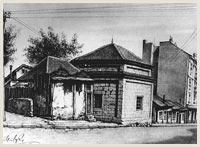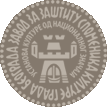|
| |
| |

ОПШТИ ИЗГЛЕД
|
| |

ТУРБЕ ШЕИХ МУСТАФЕ, ЦРТЕЖ ЛУКЕ МЛАДЕНОВИЋА
|
| |

ТЕКИЈА И ТУРБЕ ШЕИХ МУСТАФЕ, ЦРТЕЖ ЛУКЕ МЛАДЕНОВИЋА
|
| |

ТУРБЕ ШЕИХ МУСТАФЕ И ТЕКИЈА, ЦРТЕЖ
|
| |
 |
| |
|
|
|
|

ОПШТИ ИЗГЛЕД
|
|
| |
| |
Cultural monument of great value
Tomb of Sheik Mustapha,
1, Višnjićeva Street
Споменик културе од великог значаја
Турбе шеих Мустафе,
Вишњићева 1
|
|
|
|
|
|
The religious school of Hajji-Sheik Muhammad was located on the corner of the present day Studentski trg (Students Square) and Višnjićeva Street. It was dedicated to the dervishes of the powerful dervish order Cadiri. It consisted of the school building (the main building) and the tomb built in 1783 over the grave of Hajji-Sheik Mustapha, dervish and head of the school for some time. The school building was rectangular. Its longer side was turned toward the square, and observed from there the house seemed to be a ground-floor one. However, because of the incline of the plot, it was a one-storey house from the courtyard. The tomb of Sheik Mustapha was built in 1783-84 as written on the plaque above the entrance. It has a hexagonal plan with a hexagonal tambour rising above it and holding a dome with a circular base. It is built in stone. The stone frame of the portal and the dividing cornices are done in relief. The interior is decorated with inscriptions from the Quran. In the centre there is a covered sarcophagus that marks the grave (or graves). The tomb of Hajji-Sheik Mustapha and the religious school of Hajji-Sheik Muhammad are related to historic events of momentous importance for the relationship between the Ottomans and the Serbs, the occupiers and the liberators. During the Serbian Uprising 1804-1813 the religious school served for some time as the seat of the Executive Council, the highest authority in the newly established state. Also, Dositej Obradović died in it in 1811. |
| |
 |
| |
 |
| |
|
|
|
| |
Текија хаџи-шеиха Мухамеда се налазила на углу данашњег Студентског трга и Вишњићеве улице. Била је посвећена дервишима моћног дервишког реда Кадири. Сачињавали су је зграда текије (главна зграда) и турбе саграђено 1783. године на гробу хаџи-шеиха Мустафе, дервиша који је једно време био старешина ове текије. Зграда текије је имала правоугаону основу. Дужом страном била је окренута тргу, са којег се видела као приземна, док је због терена у паду из дворишта била једноспратна. Турбе шеиха Мустафе саграђено je 1783-1784. године што се може прочитати са плоче над улазом. Турбе има шестоугаону основу над којом се уздиже такође шестоугаони тамбур који носи куполу кружне основе. Озидано је каменом. Камени оквир портала и подеони венци су профилисани. Унутрашњост је украшена записима из Курана. На средини просторије налази се покривен саркофаг који обележава сам гроб (или гробове). За текију хаџи-шеиха Мухамеда и турбе шеиха Мустафе везани су судбоносни историјски догађаји за међусобни однос Турака и Срба, освајача и ослободилаца. Текија је у српском устанку 1804-1813. године једно време служила као седиште Правитељствујушчег совјета, највише извршне власти новостворене државе. У њој је 1811. године умро Доситеј Обрадовић. |
| |
Службени гласник СРС бр. 14/79 |
|
|
| |
|
|
|
|
|
|
|
|
|
|
|